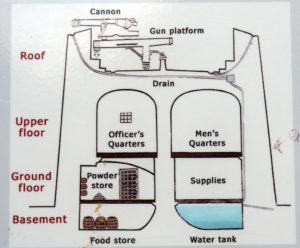A chain of defensive towers were built along the south coast between 1805-1810 to defend against a potential invasion by Napoleon. Of the 103 towers originally built, only 43 remain and many have been converted to other uses or are derelict. The Wish Tower in Eastbourne is one of only two to survive intact.
At the time, Eastbourne was four or five small settlements and, along with the Redoubt (separate review) to the east, this is one of the oldest buildings left in Eastbourne.
The design of the round towers was based on one the Royal Navy had encountered earlier at Mortella Point in Corsica, which had successfully resisted attack, armed with just three canons. The name is probably a mispronunciation of Mortella.
Although circular fortified towers had been built from prehistoric times as strongholds or look-outs, they had fallen from favour in most of Northern Europe in the late C15th after the invention of gunpowder and artillery led to radical changes in the design of fortifications. Around the Mediterranean however, piracy remained a problem and stone towers continued to be built for defence and lookout.
Based on experience at Mortella, it was realised that well-built gun-towers had an important role to play in defence from attack by sea. Built at close intervals they would provide effective cross fire against enemy attack. Even if the French were able to land artillery and subdue a number of towers, the resultant delay would provide vital time for the main British forces to concentrate and to contain the enemy.
The round towers were simply designed and quick to build. They were 40’ high with walls 8’ thick. Some, like this one had a dry moat round for extra defence. There was a high parapet around the top with a raised platform in the centre for the cannon that had 366˚ fire. Below, wooden floors divided the tower into living quarters and stores.
Originally, the only access was by ladder through a first floor doorway, giving access to the living quarters. This was later replaced by a drawbridge/.The ladder could be pulled up if necessary and stored inside the tower. Each tower had as garrison of 15-24 men and one officer. Fireplaces were built into the walls for heating and cooking. A well or cistern provided fresh water.
“Martello Tower 73,”:https://live.staticflickr.com/65535/49793697133_53a3894d20_b.jpg
also known as the Wish Tower, occupies a raised area at the south west end of the beach. It gets the name from the watery meadow close by called the ‘wish’.
The tower is surrounded by a dry moat for extra defence with a single gateway. Entry was through a door on the first floor. Small windows were the only source of natural light to first floor rooms.
Between 1812 and 1860 the tower was used as a coastguard station to protect the town against smuggling which was rife at the time. In 1873, when the immediate danger of invasion had finally passed, the tower was decommissioned by the War Office. Shortly after this it was leased by the Eastbourne Local Board and rented to the Hollobon family who ran the tower as a geological museum until about 1930.
During the Second World War, the tower was adapted with a structure on the roof and naval guns in front of the tower and used as a battery. Eastbourne was the most severely bombed non-military town on the south coast, possibly as Hitler’s plans for invasion had identified Pevensey Bay and Cuckmere Haven as sites of beach landings.
In the late 1950s, the tower was nearly demolished. It was ‘scheduled’ as a monument and some repair work carried out. At the same time, the popular “Wish Tower Cafe” was built on the site which is now the Western View Cafe.
In the 1970s a military museum was based at the tower which operated until the 1990s when a puppet museum took its place.
The tower was empty between 2001 and 2013. Since then the Wish Tower Friends were formed to restore the tower and improve public access. The tower has been shut since the start of Covid lockdowns in 2020 and has yet to reopen, apart from a few special events and occasional tours.
The area inside the moat has been planted up as a Peace Garden in memory of Eastbourne residents who lost their lives during the aerial bombardment between 1940-1944.
The exterior is freely accessible by the public and the outside is worth viewing.
“Website”:http://www.wishtower.org.uk/
There is more information about Martello towers “here.”:https://martellotowers.co.uk/








